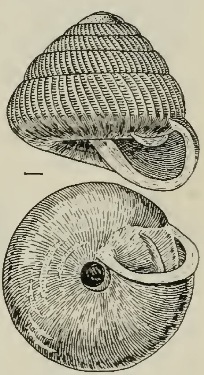Adaptation
Strobilops affinis has several adaptations that make it suitable for the environment it lives in. The first key adaptation is the color of the shell. Strobilops affinis has a dark shell, as do all members of the genus Strobilops, that does not reflect light well when the sun hits it. This helps with predator evasion during the day time. Another adaptation that the S. affinis has is similar to the adaptation that the species Strobilops labyrinthica has. Strobilops labyrinthica has a thick shell with a narrow aperture (Hotopp, 2005). Both of these features allow S. affinis to easily blend into the surrounding environment and decrease the effects predation.
Strobilops affinis is a member of the order Stylommatophora. One of the distinguishing characteristics for this order is pairs of tentacles. At the end of the top pair of tentacles there are eyes. These tentacles serve as the main sensory organs in S. affinis (Burch, 1962). The eyes are not as developed as human eyes but can distinguish the difference between light, dark, and shadows. The main sensory organs in S. affinis are the lower pair of tentacles. These tentacles are very sensitive and send fast signals to the nervous system. The tentacle and the foot also have nerve cells that can react to vibrations in the enviroment (Hess, 1974).
Strobilops affinis, like most other mollusks, does not move far during a lifetime. Snails move at a slow pace and only travel approximately seventeen miles per year (Hess, 1974). The organ that is used for movement is called the foot. This is a muscular organ that contracts to allow movement (Burch, 1962).
The status of S. affinis in Wisconsin is dwindling. The state of Wisconsin has S. affinis listed as a species of special concern with no laws protecting the species. This species has an estimated 21 to 100 occurrences in the State of Wisconsin and is considered rare and uncommon. On a global level S. affinis is generally secure as a species. Strobilops affinis is scarce in some parts of the published range and also has little to no occurrence near the edges of the the published range this species is found in (Endangered Resources Program Species Information: Eightfold Pinecone- Strobilops affinis, 2009). Since S. affinis is not a widely studied terrestrial snail, the actual occurrences in nature are thought to be greater than expected.
